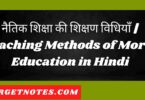
Describe different methods of English teaching. What are their advantages and disadvantages? Describe in brief the Translation-cum Grammar method of English teaching.
Contents
Methods of English Teaching
The problem of methods of teaching a subject is of recent origin. For, what was taught in the days of our forefathers, was not much concerned with ‘method’ in particular. It should, however, not lead us to think even for a while that the teachers of our forefathers followed no method. They certainly did. It is our fancy that we like those methods or discard them in toto. With the growth of scientific thinking in every walk of life, more emphasis has begun to be laid upon ‘method to be adopted in order to achieve an objective in a systematic way. Mere achievement is not sufficient in our days. We should know ‘how’ achievement is possible. Therefore, in order to know how to achieve, logically speaking, we should know first ‘what’ to achieve. “The questions”, writes Bertrand Russell, “what should be taught ?” and “how should it be taught ?” are intimately connected, because, if better methods of teaching are devised, it is possible to learn more,” i.e., if we desire to obtain better results of our teaching a subject, we must devise and adopt better methods. This will be following the wise saying, the ways justify the end’. Turning to our familiar simile of journey with an aim in view, we may safely assume that we must immediately “prepare to equip ourselves with the best possible material and to commence on our journey by the safest means so as to reach our destination in time.” Speaking plainly, when we have got our objectives defined and fixed our attention to achieve those aims, we must now suppose those methods which may help us in attaining the desired objectives.
The Translation-cum-Grammar Method
This method has enjoyed the widest popularity in the teaching of English. As a matter of fact, this method has been followed everywhere, specially where the necessity of learning a second language other than the mother-tongue or regional language has been felt. Even the learned teachers of the classical language like Persian, Sanskrit and Arabic, followed this method. Latin, English, Greek, French, German etc., have also been taught by this method. It is of late that the demerits of this method led the serious thinkers and educationists to bid good-bye to it and find out some other methods suiting to the changing times and environment.
Its very title suggests that words, phrases and sentences are to be taught with the help of mother-tongue i.e., in the case of English teaching a word-for-word translation of English words, phrases and sentences should be taught by translating them into the mother-tongue. The idea is that the vocabulary and phraseology of a foreign language can be best learnt through translating its meaning into the mother-tongue.
The followers of this method lay much emphasis on the meaning of new words’. Phrases and sentences come last. The unit of teaching is ‘word’ and not a ‘sentence’. Set rules and principles of Grammar are thrust upon the children. Grammar is taught by deductive method.
Characteristics : From this narration, we can safely find out the following principles and characteristics of this method-
1. The unit of teaching is word and not sentence.
2. Mother-tongue dominates the teaching of English as the method requires the translation of each word into the mother-tongue.
3. “The linguistic material presented for study is graded on a grammatical plan.” Therefore, it is assumed that a comparative and contrasted study of the grammar of the mother-tongue helps in mastering the grammar of English.
4. During the process of translation and comparative study of grammar, the structure of English language can be easily and conveniently learnt.
Hence, translation interprets the foreign phraseology best. “In the process of interpretation, the foreign phraseology is assimilated. By a comparative study of the grammar of the mother-tongue, the structure of a foreign language is best learnt.”
Storm’s View- The German scholar Storm emphasises the significance of Translation’ in the following words: “It is not till one can translate the word that one has complete mastery over it, so that one not only understands it, but can use it.” Storm says that the mastery over words can be gained by the comprehension of foreign phraseology which the translation readily offers. This comprehension tends to assimilate the foreign phraseology which results in its usage. Storm’s view is subject to further criticism. Power to use a phraseology is not only a matter of apprehending it. It requires practice.
Unless sufficient practice is given, power to use it does not necessarily come. “Translation, of course, is the first step to the process of assimilation.” “No one can learn a language without exerting the faculties of association and memory.”
Its Process- (The Indian Scene)- Translation lays stress upon reading. Without reading, a word-for-word’ translation is not possible. The teacher goes on reading word after word and sentence after sentence, translating them into the mother-tongue. The children sit as passive listeners, with their heads dropped below, their eyes sometimes looking into their books, mostly to their right and left and all their interest and attention is fixed, not upon what the teacher is reading but upon the gossips, which their neighbours are indulging in or upon the drums and pipes turning some film-song outside the classroom. They seem to conclude and they are right to do it, that they have nothing to do with the reading of their teacher-that their burdensome load is borne by their teacher. Their part is to remain light-as light as they had been, when they left their homes. Messers Thompson and Wyatt rightly says: “Often there is more of the mother-tongue than English in a lesson given according to the translation method and there is not the direct contact with the foreign tongue necessary for assimilation to take place.”
A judicious use of mother-tongue is frankly advisable in the teaching of English. There are words, phrases and idioms that can be easily and conveniently learnt if a reference to the mother-tongue is given. There are words, phrases and idioms that if we try to explain them in English, we cannot do so unless we do it through the mother-tongue. We conclude this point by saying this much that translation is a powerful aid in the interpretation of a foreign language, provided it is not used in excess and in all explanation the mother-tongue is to be used until such times as the pupil is in a position to follow and profit by an explanation in English…” The exclusion of the mother-tongue will be fatal and will prove “a vicious procedure productive of most harmful results.”
Merits of the Method-
1. It enables a better and quicker understanding of words, phrases and idioms which can be translated into the mother-tongue. Thus, it provides for clearness by avoiding vagueness. It also makes for exactness and definiteness as the pupils has to search for an equivalent in his mother-tongue.
2. It is based on the principles of ‘proceed from Known to the Unknown’. Children usually start learning a foreign language when a sufficient background in their mother-tongue is prepared and they have acquired and adequate vocabulary in their mother-tongue. They also begin to understand sentences nd structures in their mother-tongue. Thus, in translating a foreign word into their mother-tongue they have simply to find out an equivalent word in their mother-tongue. The working knowledge of mother-tongue helps them to learn the grammar of a foreign language.
3. Its judicial use helps the children in understanding vocabulary. The process is economical. It saves time. It is effective.
4. We can test the comprehension of our pupils by this method.
5. Through translation, a strong memory bond is established as the child associates the foreign phraseology with that of his mother-tongue. Thus, it offers the shortest way to learn a foreign language.
Demerits of the Method-
1. Literal translation ruins the sense and beauty of a sentence. If proper attention is not paid the danger of vernacularism is always there, e.g., “He goes to the market” or “He reads a book”. Not only this, we hear sentences like these: “The road began to walk” for “Sarak chalne lagi” or “My head is eating circles” for “mera sar chakkar kha raha hai” etc., from our children. This may happen by way of fun. But if it is not nipped in the bud, it may result in forming a regular habit and therefore vernacularism will creep in.
2. Language is the product of a particular culture which is shaped by its geographical situation, climate, nature and human beings, their habits, their modes of living and behaviour, etc. In return, language interprets all these. This is true of each language and this is the reason that no two countries, no two culture, no two climates and environments, are similar. “The thoughts, feelings, surroundings and customs of one nation differ from those of another, these differences are reflected in the languages and colour the connotions of the simplest word.” There is hardly a perfect language on earth which can interpret all cultures and all environments. The vocabulary, idioms and phrases, which are evolved in the culture and environment of a particular nation, seldom find matching equivalents in any other language. The distinction in the structure of English language, if compared to those of Indian languages, also makes the translation impossible. ‘A’ and ‘the’ used before a noun cannot be translated. The complex English sentences, which have no equivalent in the Indian languages and some of the prepositions which create a wealth of phrases find no equivalent in Indian languages and offer difficulties in word-to-word translation.
3. One of the serious limitations of this method is that it neglects the speech practice. It also minimises the opportunities of reading aloud by the pupils. Reading and writing come before speaking. In the foregoing pages, I have been laying emphasis on the spoken aspect of language learning and their logical order viz., Speech, Reading and Writing. In fact, reading and writing should follow the speech practice.
4. I have said that Grammar plays an important role in translation method. The scheme of a course of lesson based on grammatical principles may appear logical to an adult mind but its grammatical bias is detrimental to the interest of the young learners. The lessons taught become dry and burdensome and the pupils soon get tired of paying attention to the learning of a foreign language. “The Grammar of a language is the description of the language- something about the language.” It is a set of rules and paradigms governing the structure of the language. Thus, grammar should follow language and not consider for a moment the teaching-learning process of mother-tongue. Before a child comes to school, he learns it from his parents who teach him in a direct and natural way. They do not teach him the rules of language. They simply present before the child a proper context and teach him language by using it appropriately in that context. In the like manner, his friends expand his vocabulary and sentence-patterns in proper context.
This method does not leave much opportunity for the children to learn by imitation which helps them to pick up a language. Sweet expresses is opinion that only a limited number of sentences can be taught by this method. We have to do away with the rigid and fixed rules of a grammar method. Training in speech is not possible by this method. In this connection, according to Dr. Ballard, “To speak any language whether native or foreign, entirely by rule is quite impossible.”
5. Translation method does not offer opportunities for silent reading also which is most needed in the comprehension of texts at the school stage. It will stand in their way of reading journals and newspapers and they will not enjoy books by their self-reading in their later life.
6. This method also fails to arrest the delicacy of expression local colour and secondary meanings. This method also fails to arrest the ‘soul’ of the word and the mind of the author.
7. This method does not create direct bond between thought and expression. “Children begin thinking in their mother-tongue and then they convert their ideas into English. They form the habit of using their mother-tongue in excess “and the result is”, writes Moore in Modernism in Language Teaching “that having done the translation the pupil is almost as far from the goal as ever.” The child who is brought up on this method is like “the would-be swimmer”, says Morris, “who fears to let go his hold on the bath rail, and if employed to do, either makes spasmodic efforts at swimming in shallow water or soon gets out of his depths with disastrous consequences.”
8. I have already mentioned that the unit of teaching in this method is a word and not a sentence. The pupils break up sentence into words instead of absorbing its meaning as a whole. This literal approach puts a check on cultivating a habit of rapid reading.
Conclusion- Having said this much on the debit and credit side of the Translation-cum Grammar method, let us look at the balance sheet and assess its value. This method, in spite of so much research in methodology, is still practised in our class-rooms. We cannot overlook the disadvantages of this method and thus there is need to shift the emphasis to some other practical, economical and effective method. Our teachers seem to neglect the modern method. They also seem to agree with Mr. Ronald Mackin: “In the teaching of modern languages, perhaps more than in any other teaching, we find completely opposed methods of instruction working with success. There is the grammar grinder of the old school, who derides phonetics, gramophone, oral work, rejects all the more recent findings of teaching method, treats his language as though it were dead, yet fills his pupils with an enthusiasm for language and culture that many others, playing records, dramatics, correspondence and epidiascope, can but partially attain. Some men can succeed in their highly personal approach, however odd and unworkable this may appear to him.” Yes, some men can succeed as “some men have succeeded.” But this set of some skilled persons, is fast disappearing. Besides, times are changing rapidly and so are our needs and requirements. Our aims of teaching English have totally changed and we need not waste our time and energy in following this out-dated method. To, day emphasis is laid on ‘objective approach. That is, on the scientific process which leaves no room for the application of this method.
Indian Conditions- Indian conditions as they are, may support ‘Grammar and Translation Method’. There is acute shortage of well-trained teachers in new methods. Our institutions do not encourage and supply suitable environment in which a teacher may work efficiently, even though his efficiency is measured by the percentage of his results. Teachers are low and insufficiently paid. A half-starved teacher, with ill-equipped class-rooms and no teaching class-room material aid with a heavy load of ‘extra work’ upon his head, unmethodically written text-books, traditional set-up of examinations, cannot prove to be an efficient teacher in the sense of producing a high percentage of qualitative result. Often teachers have to be the victims of the snobbery of their employers and have to work in unimaginable circumstances. Hence, for all of us, grammar and translation method may appear to be the only working method until times and circumstances favour to try new methods of teaching.
Some Practical Suggestions (For improved use of this method):
1. Avoid word for word translation. It is never helpful because the structural composition of English and mother-tongue of the pupils will always be different. Word for word translation, therefore, creates psychological disorder in the understanding of the structures, word-order and grammatical compositions. Read aloud a part of the given paragraph. Meaning of difficult words. should be given both in English and in their mother-tongue. Ask the pupils to read this part silently. Either put a question to elicit its answer to ensure that they have understood it. Here they should be expected to give answer in their mother-tongue. Accepting this answer the teacher should write it and its equivalent in English on the black-board and drill it to establish it. From this pass on to the other or the remaining part and to likewise. At the end of the lesson build a comprehensive summary both in English and in their mother-tongue. Or you can shift this exercise to another period of either translation or composition.
Decidely this is all time-consuming and demanding great pairs. But once practice is established and pupils gain experience, both the consumption of time and labour will be saved and each teaching period will be a success.
2. As far as possible, each question should be addressed to the whole class. The teacher should decide which pupil should be asked to answer it after he has had a chance to see the reactions of the whole class. “That is the teacher should not ask questions round the class.” If he does so, the pupils will “let their attention wander when they know they are safe for a time from questioning.”
3. Pupils should be asked to do written work in sufficient quantity. Here the problem of correction will arise. I have elsewhere said that pupils should be asked to correct each other’s work. It is possible that they may become ‘generous’ and overlook the mistakes of their friends. The teacher may check from time to time and penalise the marker and the markee for such overlooked or undetected errors. “The task of marking and correcting written work can also be made easier by setting strict limits on the amount to be written in free composition…. by choosing formulas that permit of a single unambiguous answer; by working over exercises orally in class before setting them as home-work; by building up model answers on the blackboard through question and answer and so on.”
4. Mr. Mackin suggests another time-saving device for correcting the mistakes of the pupils. While correcting the exercises of his pupils, the teacher will indicate those mistakes. The teacher keeps a note of, say, twenty typical errors which he considers to be of more importance than the others. When he hands the work back he invites individual to pick out of their own work certain errors of which they think they know the correct version. It is, of course, psychologically sound to give who has perpetrated an error the first opportunity of putting it right.
5. “Love of competition” should be created among the pupils. Large classes should be divided fairly, evenly and a spirit of healthy rivalry between teams should be created. Organised programmes in vocabulary and meaning of idiomatic expression, etc., may be carried on in a large class. The teams may be named and written on the black-board. “Whole teams can be promoted or demoted according to the results of a competition….” But these activities can be carried on only when the teacher has a “good control of the class.”
6. The class should be initiated to sing songs in English. “For it the class should be broken up into groups of about 15. For this chorus work it should be taught the virtues of clear diction combined with low volume….. It soon becomes possible to have different songs sung by the various groups on different occasions.” In India, as we will have difficulties in catching up the techniques of English music, we may depend upon recitation of simple lyrics.
7. If a pupil still persists in making two or three mistakes, “he should select one particular kind of error in the work of each pupil, correct it, require him to write a number of sentences in a given pattern as a first step to drilling out the mistake and subsequently give penalties whenever the same pupil repeats this type of mistake.”
IMPORTANT LINK
- डाल्टन पद्धति का क्या तात्पर्य है ? डाल्टन-पद्धति का उद्देश्य, कार्य प्रणाली एंव गुण-दोष
- बेसिक शिक्षा पद्धति | Basic Education System In Hindi
- मेरिया मॉन्टेसरी द्वारा मॉण्टेसरी पद्धति का निर्माण | History of the Montessori Education in Hindi
- खेल द्वारा शिक्षा पद्धति का क्या तात्पर्य है ?
- प्रोजेक्ट पद्धति क्या है ? What is project method? in Hindi
- किण्डरगार्टन पद्धति का क्या अर्थ है ? What is meant by Kindergarten Method?






